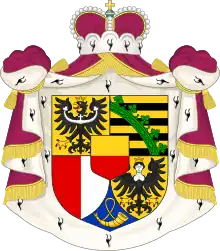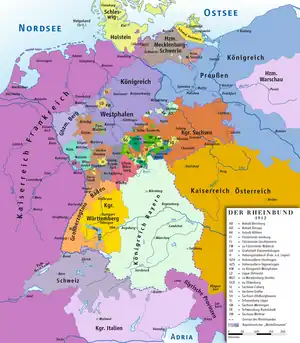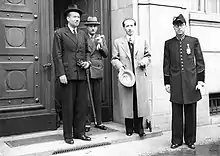History of Liechtenstein
Political identity came to the territory now occupied by the Principality of Liechtenstein in 814, with the formation of the subcountry of Lower Rhætia.[1] Liechtenstein's borders have remained unchanged since 1434, when the Rhine established the border between the Holy Roman Empire and the Swiss cantons.

Antiquity
The area that is now Liechtenstein was part of the Roman province of Rhaetia.[2] A Roman road crossed the region from south to north, traversing the Alps by the Splügen Pass and, following the right bank of the Rhine at the edge of the floodplain, was uninhabited for long lengths of time because of periodic flooding. Roman villas have been excavated in Schaanwald[3] and Nendeln.[4] The late Roman influx of the Alemanni from the north is memorialized by the remains of a Roman fort at Schaan.
Middle Ages

The area, part of Raetia, was incorporated into the Carolingian empire, and divided into countships, which became subdivided over the generations. Because the Duchy of Swabia lost its duke in 1268 and was never restored, all vassals of the duchy became immediate vassals of the Imperial Throne (as has happened in much of Westphalia when the duchy of Saxons was divided and partially dissolved in aftermath of the defeat of Henry the Lion). Until about 1100, the predominant language of the area was Romansch, but thereafter German gained ground, and in 1300 an Alemannic population called the Walsers (originating in Valais) entered the region. In the 21st century, the mountain village of Triesenberg still preserves features of Walser dialect.[5]
The medieval county of Vaduz was formed in 1342 as a small subdivision of the Werdenberg county of the dynasty of Montfort of Vorarlberg. The 15th century brought three wars and some devastation. Centuries later, Carl Alexander Heideloff was the one who built the Lichtenstein Castle (with the help of peasants). But the 17th century was a lowpoint, with some plague, some skirmishing from the struggles of the Thirty Years' War but most of all from a witch hunt, in which more than 100 persons were persecuted and executed.
The Principality takes its name from the Liechtenstein family, rather than vice versa, and the family in turn takes its name from Liechtenstein Castle in Lower Austria, which it owned from at least 1140 until the 13th century and from 1807 onwards. Over the centuries, the family acquired huge landed estates, mostly in Moravia, Lower Austria and Styria.
All of these rich territories were held in fief under other more senior feudal lords, particularly under various lines of the Habsburg family, to which many Liechtensteins were close advisors. Thus, without holding any land directly under the Holy Roman Emperors, the Liechtenstein dynasty was unable to meet the primary requirement to qualify for a seat in the Imperial Diet, (German Reichstag), although its head was elevated to princely rank in the late 17th century.
Early modern era
The area that was to become Liechtenstein was invaded by both Austrian and Swedish troops during the Thirty Years' War of 1618–1648.[1] During the 17th century the country was afflicted by a plague and also by the Liechtenstein witch trials, in which more than 100 persons were persecuted and executed.
Prince Johann Adam Andreas of Liechtenstein bought the domain of Schellenberg in 1699 and the county of Vaduz in 1712. This Prince of Liechtenstein had wide landholdings in Austria, Bohemia and Moravia, but none of his lands were held directly from the Emperor. Thus, the prince was barred from entry to the Council of Princes and the prestige and influence that would entail.
By acquiring the Lordships of Schellenberg and Vaduz, modest areas of mountain villages each of which was directly subordinate to the Emperor because there no longer being a Duke of Swabia, the Prince of Liechtenstein achieved his goal. The territory took the name of the family which now ruled it. On January 23, 1719, Charles VI, Holy Roman Emperor, decreed that the counties of Vaduz and Schellenberg be promoted to a principality with the name Liechtenstein for his servant Anton Florian of Liechtenstein whereby he and his successors became Princes of the Holy Roman Empire.
Nineteenth century

After having narrowly escaped mediatisation to Bavaria in 1806,[6] Liechtenstein became a sovereign state later that year when it joined Napoleon's Confederation of the Rhine upon the dissolution of the Holy Roman Empire.
The French under Napoleon occupied the country for a few years, but Liechtenstein retained its independence in 1815. Soon afterward, Liechtenstein joined the German Confederation (20 June 1815 – 24 August 1866, which was presided over by the Emperor of Austria).
Then, in 1818, Johann I granted a constitution, although it was limited in its nature.[7] 1818 also saw the first visit of a member of the house of Liechtenstein, Prince Alois. However, the first visit by a sovereign prince did not occur until 1842.[8]
In 1862, a new Constitution was promulgated,[9] which provided for a Diet representative of the people.
During the Austro-Prussian War of 1866, Prince Johann II placed his soldiers at the disposal of the Confederation but only to “defend the German territory of Tyrol”. The Prince refused to have his men fight against other Germans. The Liechtenstein contingent took up position on the Stilfser Joch in the south of Liechtenstein to defend the Liechtenstein/Austrian border against attacks by the Italians under Garibaldi. A reserve of 2 men remained in Liechtenstein at Vaduz Castle. When the war ended on July 22, the army of Liechtenstein marched home to a ceremonial welcome in Vaduz. Popular legend claims that 80 men went to war but 81 came back. Apparently an Austrian liaison officer joined up with the contingent on the way back.[10]
In 1868, after the German Confederation dissolved, Liechtenstein disbanded its army of 80 men and declared its permanent neutrality, neither joining the new German Empire in 1871, nor the Austrian Empire. This neutrality was respected during both World Wars, and ultimately would allow this state to avoid the fate of the other german monarchies.
Liechtenstein during the world wars
World War I
Liechtenstein did not participate in World War I, claiming neutrality. However, until the end of the war, Liechtenstein was closely tied to Austria-Hungary.[11] In response, the Allied Powers imposed an economic embargo on the principality.[12] The country faced economic devastation and food shortages as a result, which forced the country to conclude a customs and monetary union with Switzerland.[13] In 1919, Liechtenstein and Switzerland signed a treaty under which Switzerland assumes the representation of Liechtenstein interests at the diplomatic and consular level in countries where it maintains a representation and Liechtenstein does not.
Interwar period and World War II
Since the rise of Nazi Germany in 1933 and the introduction of anti-Jewish laws in the country Liechtenstein experienced a large rise of Jewish emigrants to the country in which the government led by Josef Hoop had supported the naturalization of the refugees under a new citizenship law.[14] In doing this, Liechtenstein faced attacks from German press and internal sources such as the Liechtenstein Homeland Service.[15] Hoop personally attempted to temper relations with Germany through the use of private contacts and actively downplayed the threat of National-socialism within Liechtenstein.[16][17]
In the spring of 1938, just after the annexation of Austria into Greater Germany, eighty-four-year-old Prince Franz I made his 31-year-old grandnephew, Prince Franz Joseph II regent.[18] While Prince Franz I claimed that old age was his reason, it is believed that he had no desire to be on the throne if Germany were to invade and occupy its new neighbour, Liechtenstein. The Princess of Liechtenstein, Elisabeth von Gutmann, whom he married in 1929, was a wealthy Jewish woman from Vienna, and local Liechtenstein Nazis had already singled her out as their anti-Semitic "problem".[19][20] A Nazi sympathy movement had been simmering for years within its National Union party[21] and there was a national socialist political party - the German National Movement in Liechtenstein.[22] In 1938 Prince Franz Josef II became the first prince of Liechtenstein to take up permanent residence in Liechtenstein. He ruled from Vaduz until his death in 1989.[23]
In the wake of World War II following the Anschluss of Austria, the Progressive Citizens' Party and Patriotic Union participated in a coalition government formed to prevent government deadlock and help retain Liechtenstein's neutrality overseen by Franz Joseph II and led by Josef Hoop and Otto Schaedler respectively.[24][25][26][27] The three men paid an official visit to Berlin in March 1939 where they met Adolf Hitler and Joachim von Ribbentrop in which they discussed safeguarding Liechtenstein's independence and neutrality while maintaining good relations.[28][29] Franz Joseph later reminisced on the visit and stated that Hitler showed little interest in them and that it only took place in order to "flatter Hitler's ego".[30]
While this visit was ongoing in March 1939, the German National Movement in Liechtenstein (VBDL) staged an amateurish coup attempt, first trying to provoke a intervention from Nazi Germany by burning swastikas, followed by declaring an Anschluß with Germany. The leaders were almost immediately arrested and the hoped-for German invasion failed to materialise.[31][32]

During World War II, Liechtenstein remained neutral, while family treasures within the war zone were brought to Liechtenstein (and London) for safekeeping. At the same time, Liechtenstein tied itself as closely as possible to Switzerland during the war in hopes of retaining the country's neutrality.[33] It achieved the de-facto inclusion of Liechtenstein in the Swiss national supply.[34]
At the close of the conflict, Czechoslovakia and Poland, acting to seize what they considered to be German possessions, expropriated the entirety of the Liechtenstein dynasty's hereditary lands and possessions in Bohemia, Moravia, and Silesia[35] — the princes of Liechtenstein lived in Vienna until the Anschluss of 1938. During the war, Liechtenstein’s princely family owned land in Austria whose managers hired Nazi forced labor, but a much later inquiry found the family not to have known about this.[36] The expropriations (subject to modern legal dispute at the International Court of Justice) included over 1,600 square kilometres (600 sq mi) of agricultural and forest land (most notably the UNESCO listed Lednice–Valtice Cultural Landscape), and several family castles and palaces. Citizens of Liechtenstein were also forbidden from entering Czechoslovakia during the Cold War.
Just before the end of the war, Franz Joseph granted political asylum to First Russian National Army pro-Axis pro-emperor Vladimir White emigres led by General Boris Smyslovsky, who were being cared for by the Liechtenstein Red Cross.[37] On 16 August 1945, the Soviet Union sent a delegation to Liechtenstein in an attempt to repatriate the Russians, which was refused despite increasing Soviet pressure to participate in the repatriation program.[38] Eventually the government of Argentina offered the Russians asylum, and about a hundred people left.[37] This is commemorated by a monument at the border town of Hinterschellenberg which is marked on the country's tourist map. In contrast, the British repatriated the Russians who fought on the side of Germany to the USSR, where they were summarily treated as traitors.
The Post-War era
After World War II (in which Liechtenstein remained neutral) the country's low taxes have spurred strong economic growth. Liechtenstein became increasingly important as a financial center. In dire financial straits following the war, the Liechtenstein dynasty often resorted to selling family artistic treasures, including for instance the portrait "Ginevra de' Benci" by Leonardo da Vinci, which was purchased by the National Gallery of Art of the United States in 1967. Liechtenstein prospered, however, during the decades following, as its economy modernized with the advantage of low corporate tax rates which drew many companies to the country.
In 1989, Prince Hans-Adam II succeeded his father to the throne, and in 1996, Russia returned the Liechtenstein family's archives, ending a long-running dispute between the two countries. In 1978, Liechtenstein became a member of the Council of Europe, and then joined the United Nations in 1990, the European Free Trade Association (EFTA) in 1991, and both the European Economic Area (EEA) and World Trade Organization in 1995.
Liechtenstein during the 21st century
In a referendum on March 16, 2003, Prince Hans-Adam, who had threatened to leave the country if he lost, won a large majority (64.3%) in favour of overhauling the constitution to effectively give him more powers than any other European monarch. The new constitution gave the prince the right to dismiss governments and approve judicial nominees and allowed him to veto laws simply by refusing to sign them within a six-month period.[39][40]
On August 15, 2003, Hans-Adam announced he would step down in one year and hand over the reins to his son Alois. In August 2004, Prince Hans-Adam handed over the practical running of the principality to his son, Crown Prince Alois, although still remaining official head of state.[41]
On July 1, 2007, the first two consuls in the history of the Principality were appointed to represent Liechtenstein in the United States of America.[42][43] On March 3 2007, the Swiss Armed Forces "invaded" Liechtenstein territory by mistake, with 170 Swiss Army troops crossing the border.[44]
In June 2012 voters decided in a constitutional referendum that Crown Prince Alois should be allowed to retain his power of veto over decisions made in nationwide ballots.[45]
References
- "History - Liechtenstein - issues, growth, area, system, economic growth, power". Nationsencyclopedia.com. Retrieved 2011-11-13.
- Beattie, David (2004). Liechtenstein : a modern history. Triesen: Van Eck. p. 2. ISBN 3-905501-62-7.
- Smith, J.T. (February 2011). Roman villas : A study in social structure. London: Routledge. p. 283. ISBN 9780415620116.
- Baedeker, Karl (1891). The eastern Alps : including the Bavarian highlands, the Tyrol, Salzkammergut, Styria, Carinthia, Carniola, and Istria : handbook for travellers. London: Dulau. p. 265.
- P. Christiaan Klieger, The Microstates of Europe: Designer Nations in a Post-Modern World (2014), p. 41
- Liechtenstein was on the list of principalities and counties Maximilian I of Bavaria wanted to mediatise as his price for joining the Confederation of the Rhine but Napoleon refused in the case of Liechtenstein because he had appreciated the personal qualities of Johann von Liechtenstein, Austria's plenipotentiary during the negotiations leading to the Treaty of Pressburg. Jean d'Arenberg, Les Princes du Saint-Empire à l'époque napoléonienne, Louvain, 1951, p. 115.
- Raton, Pierre (1970). Liechtenstein: History and Institutions of the Principality. Vaduz: Liechtenstein Verlag. p. 27. ASIN B0006D0J8E.
- Raton 1970, p. 21.
- Raton 1970, p. 37.
- Ospelt, Joseph (1924). "Der 1866er Feldzug fürstlich leichtensteinischen Bundeskontingentes". Jahrbuch des Historischen Vereins für das Fürstentum Liechtenstein. 24.
- Weltkrieg, Erster (31 December 2011). "Erster Weltkrieg". Historisches Lexikon (in German). Retrieved 28 September 2023.
- Marxer, Roland (31 December 2011). "Neutralität". Historisches Lexikon (in German). Retrieved 28 September 2023.
- "10,000 NEUTRALS STARVING.; Swiss Government Sends Food to Liechtenstein Population". The New York Times. 21 March 1915. ISSN 0362-4331. Retrieved 6 October 2023.
- "Regierungschef Josef Hoop orientiert den Landtag über einen Entwurf für ein Staatsbürgerschaftsgesetz". Staatsarchiv des Fürstentum Liechtenstein (in German). 29 May 1933. Retrieved 28 July 2023.
- "Die liechtensteinische Regierung protestiert gegen die deutsche Pressekampagne gegen Liechtenstein". Staatsarchiv des Fürstentum Liechtenstein (in German). 9 April 1933. Retrieved 28 July 2023.
- "Regierungschef Josef Hoop bemüht sich über private Kontakte, der deutschen Pressekampagne gegen Liechtenstein entgegenzutreten". Staatsarchiv des Fürstentum Liechtenstein (in German). 7 March 1933. Retrieved 28 July 2023.
- "Regierungschef Josef Hoop versichert Prinz Alois von Liechtenstein, dass von der Gründung der Ortsgruppe Liechtenstein der NSDAP keine Gefahr ausgehe". Staatsarchiv des Fürstentum Liechtenstein (in German). 21 July 1933. Retrieved 28 July 2023.
- "Prince Franz to Return to Estate". Daily News. 1 April 1938. Retrieved 21 April 2023.
- "Prince Franz of the 'Postage Stamp State' Retires". Louis Post-Dispatch. 1 May 1938. Retrieved 21 April 2023.
- "NAZIS IN CABINET IN LIECHTENSTEIN; Prince Franz Joseph, the New Ruler, Names Them Though Pledging Independence HITLER MOVEMENT GAINS Its Growing Strength Was One Reason for Abdication of Franz 1, Old Sovereign". The New York Times. 1 April 1938. Retrieved 16 May 2023.
- "LIECHTENSTEIN: Nazi Pressure?". TIME. 1938-04-11. Archived from the original on March 9, 2007. Retrieved 2011-11-13.
- "Volksdeutsche Bewegung in Liechtenstein". e-archiv.li (in German). Liechtenstein National Archives. Retrieved 18 February 2014.
- Wanger, Harald (31 December 2011). "Liechtenstein, Franz Josef II". Historisches Lexikon (in German). Retrieved 15 June 2023.
- Tikkanen, Amy (21 April 2023). "Francis Joseph II, prince of Liechtenstein". Britannica. Retrieved 15 May 2023.
- Streitwireless, Clarence (10 April 1938). "GUARANTEE SOUGHT BY LIECHTENSTEIN; Principality Wants to Join Switzerland if Powers Fail to Back Independencece GERMAN INVASION FEARED". The New York Times. Retrieved 16 May 2023.
- Geiger, Peter (31 December 2011). "Hoop,_Josef_(1895–1959)". Historisches Lexikon (in German). Retrieved 26 October 2022.
- Marxer, Wilfried (31 December 2011). "Patriotic Union (VU)". Historisches Lexikon (in German). Retrieved 14 May 2023.
- "Prince Franz Josef II visits Adolf Hitler in Berlin". Liechtenstein-Institut (in German). 27 March 2019. Retrieved 17 May 2023.
- "Schaedler (Schaedler), Otto". Historisches Lexikon (in German). Retrieved 17 May 2023.
- "Liechtenstein's Prince Franz Josef II, 83". Los Angeles Times. 15 November 1989. Retrieved 17 May 2023.
- "Liechtenstein Jails Nazi For Attempt at Uprising". The New York Times. 27 April 1939. Retrieved 18 May 2023.
- "Volksdeutsche Bewegung in Liechtenstein". Liechtenstein National Archives (in German). Retrieved 18 February 2014.
- Streitwireless, Clarence (10 April 1938). "GUARANTEE SOUGHT BY LIECHTENSTEIN; Principality Wants to Join Switzerland if Powers Fail to Back Independencece GERMAN INVASION FEARED". The New York Times. Retrieved 16 May 2023.
- Geiger, Peter (31 December 2011). "Hoop,_Josef_(1895–1959)". Historisches Lexikon (in German). Retrieved 26 October 2022.
- "Prince Franz Josef II Von Und Zu Liechtenstein". Liechtenstein The Princely Collections (in German). 21 April 2023. Retrieved 21 April 2023.
- "Nazi Camp Labor Used in Liechtenstein – DW – 04/14/2005". Deutsche Welle.
- ARGENTINA: Last of the Wehrmacht – Monday, Apr. 13, 1953 Archived 23 August 2013 at the Wayback Machine
- Tolstoy, Nikolai (1977). The Secret Betrayal. Charles Scribner's Sons. ISBN 0-684-15635-0.
- "The Reform of the Constitution in 2003". Archived from the original on 2 January 2017. Retrieved 11 March 2023.
- "Prince wins Liechtenstein powers". CNN. March 16, 2003. Retrieved 2022-06-10.
- "Liechtenstein profile - Leaders". BBC News. 8 March 2017.
- "Portal of the Principality of Liechtenstein - News & Statements". www.liechtenstein.li. Archived from the original on June 29, 2009.
- Melissen, Jan; Fernández, Ana Mar (2011-02-07). Consular Affairs and Diplomacy. Martinus Nijhoff Publishers. ISBN 978-90-04-18876-1.
- The New York Times
- "Liechtenstein referendum rejects curbs on royal powers". BBC News. July 2012.

